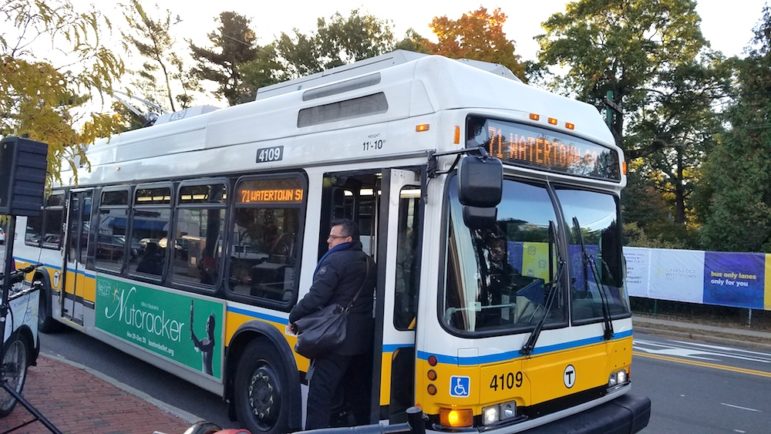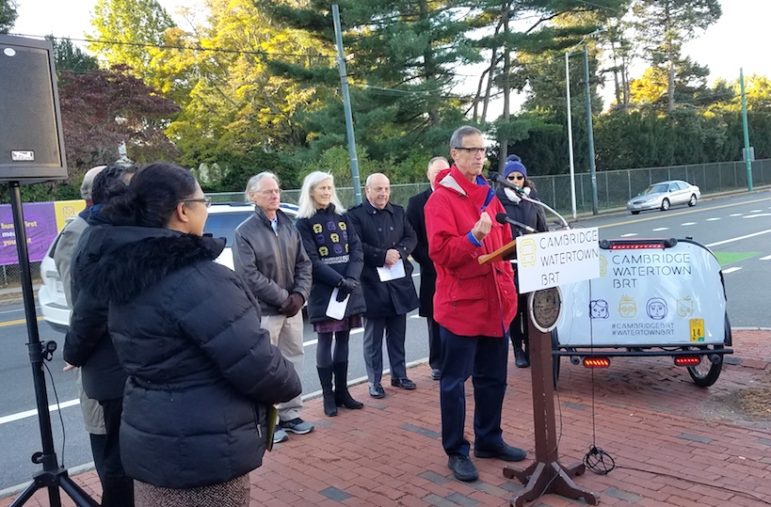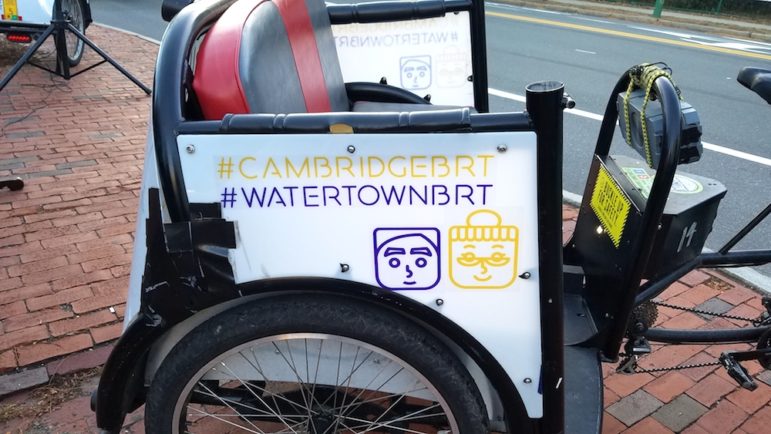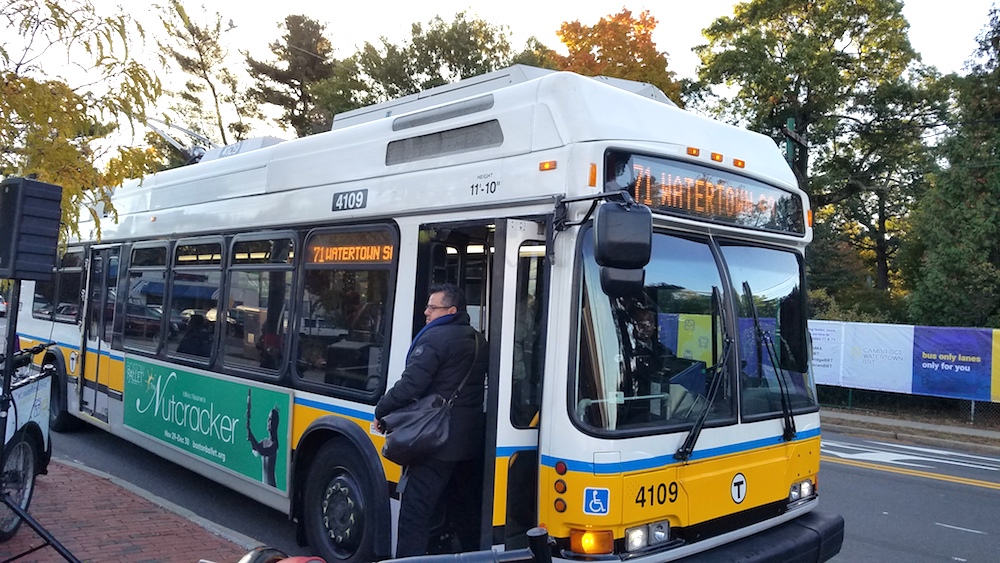
Charlie Breitrose
Buses like this one on the 71 bus will get priority heading toward Harvard Square on Mt. Auburn Street in the new Cambridge-Watertown Bus Priority Pilot program.
It takes something special to get state and local officials to gather next to a bus stop at 8 a.m. a chilly morning, but celebrating the start of a program to speed up buses along Mt. Auburn Street rose to that occasion Friday morning.
The group in front of Star Market showed up for the launch of the Cambridge-Watertown Mt. Auburn Street Bus Priority Pilot, also referred to as bus rapid transit or BRT. Users of the roadway may have noticed the red lanes, and new traffic patterns, which are designed to move buses, and — they hope — other vehicles, toward Harvard Square at a brisker pace.
The pilot — sponsored by Watertown, Cambridge, the MBTA, Department of Conservation & Recreation, the Institute for Transportation and Development Policy and funded by the Barr Foundation — not only includes changes to the area near Mt. Auburn Cemetery, but also bus queue jump lanes at the intersections with Walnut and School streets in Watertown, and Belmont Street in Cambridge; and left turn lanes for vehicles at Homer and Aberdeen streets in Cambridge. Along with MBTA buses, the bus priority lanes can be used by emergency vehicles, school buses, corporate shuttles and bicyclists.
Stephanie Pollack, secretary and CEO of the Mass. Department of Transportation, said buses are the Rodney Dangerfield of public transportation, not getting respect, despite the fact that MBTA buses carrying three times as many passengers as all the Commuter Rail Lines combined.
“Projects like this give buses the respect they deserve,” Pollack said.

Charlie Breitrose
State Sen. Will Brownsberger, speaks during the launch of the Mt. Auburn Street Bus Priority Pilot held outside Star Market. He is standing in front of state and local officials, including State Rep. Jonathan Hecht, in the leather jacket, Cambridge Vice Mayor Jan Devereux, and Cambridge City Manager Louis DePasquale.
Making a bus network work requires six things, Pollack said: buses, drivers, asphalt, a place to pull over, getting buses through intersections efficiently and space for people to wait for the bus. While the state can control the buses and drivers, many of the other things are controlled by local governments.
“There is no way to bring the six things together without collaboration,” Pollack said. “We’re here to celebrate the collaboration.”
State Rep. Jonathan Hecht, who represents parts of Watertown and Cambridge, said improving conditions on Mt. Auburn Street is a big challenge, but it could improve not only congestion, but pollution and reduce green house gases.
“We need to be bold when we think about getting people to work and home, and reduce as much as we can the impact on the planet,” Hecht said.
State Sen. Will Brownsberger, who serves Watertown, Belmont and parts of Boston, said the effort has been a long one, starting five years ago. At the time, he said, he worried that people would say there was nothing to be done, but officials from Watertown, Cambridge and the State brainstormed ideas to find ways to improve traffic flow down Mt. Auburn Street.
“I realized this intersection had not been looked at for many years,” Brownsberger said.
He added that he is hopeful the changes will also improve conditions everyone.
“The reactions from (bus) riders is they are so ecstatic, so grateful,” Brownsberger said. “We need to make sure it works for drivers, too.”

Charlie Breitrose
The logos of the Cambridge-Watertown Mt. Auburn Bus Priority Pilot, also called Bus Rapid Transit (BRT), are displayed on the side of pedicabs.
Watertown resident Mark Peterson came out to the celebration. He is a regular user of the 71 and 73 buses and hopes to see improvements to bus service from the changes.
“I have been trained to be on a bus before 7 a.m.,” Peterson said. “Maybe I will be able to stay in bed a little later, now.”
According to a traffic study of the stretch from Coolidge Avenue to Brattle Street in Cambridge buses make up 3 percent of the vehicles in the morning rush hour, but they carry 56 percent of the people traveling down the stretch. Mt. Auburn Street carries 12,000 people on buses. Officials took a different approach to the roadway, with the help of transportation consultants, said Cambridge City Manager Louis DePasquale.
“On this stretch (in front of Star Market) over half of the people travel on buses,” DePasquale said. “Howard Stein Hudson said we need to look at the people traveling down this stretch, not the vehicles. If you move buses faster, you will make more attractive and more people will ride the bus.”
Bus Priority Lanes Going Into Effect Soon, See What to Expect, Take Survey
The Mt. Auburn Street bus priority lanes are the fifth in the Boston area, said MBTA General Manager and CEO Luis Ramirez, who said he hopes the changes will help commuters and other bus riders get around more quickly.
While the Bus Rapid Transit is designed to make buses go faster, they still run into traffic jams at the Mt. Auburn Street/Fresh Pond Parkway intersection. Leo Roy, Commissioner fo the Department of Conservation and Recreation, said that his department controls that roadway, and the DCR is working with other agencies and local governments to improve the flow between Mt. Auburn Street and Gerrys Landing Road on Fresh Pond Parkway.
Watertown’s Assistant Town Manager Steve Magoon thanked the staff of the town who worked on the project, particularly Town Engineer Matt Shuman and Senior Transportation Planner Laura Wiener, as well as the department heads.
See more information about the project on here: https://www.mass.gov/service-details/mount-auburn-street-corridor-study

Why is it that the sponsors and planners are “hopeful” that it will also be beneficial to the automobile traffic? I do not see how it will be but I am patient and will wait for the results.
As someone who rides this route for work weekdays, it is awesome. Yes.
Message for those who insist on driving should be re-consider, to which I can testify that now it’s better. Give it a try.
I think that’s at least part of the ‘hope’
If even more people can be moved on buses, it will remove some of the volume, and improve the overall traffic.